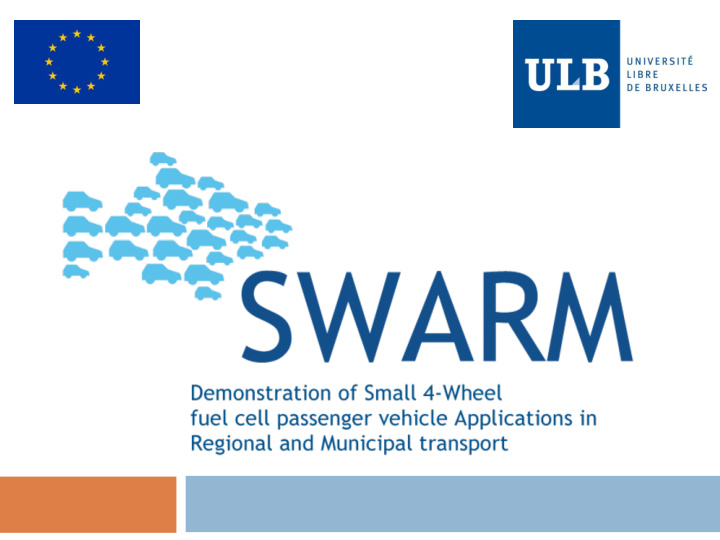



Context Drawbacks of Current Technologies Electric cars without Electric cars with range- range-extender extender Fossil fuel Engine Model Range Model Range Danger of pollution on the environment Chevrolet 56 km Hyundai 580 km Fossil fuel health risk Volt ix-35 Reduction of fossil fuel stock Nissan 117 km Honda 620 km Leaf FCX Clarity Ford 122 km Toyota 830 km Electric vehicles Focus electric FCHV-adv without range-extender Refueling Type Time Refueling Type Time Insufficient Range Home refueling ≈ 8 h Hydrogen ≈ 5 min (220 V 16 A) refueling station Too long Refueling Refueling station ≈ 20 min Fuel Cell Range-extender (400V 63A) Hydrogen Storage Electric Motor Fuel Cell Electric Energy Storage
SWARM project SWARM (“Demonstration of Small 4 -Wheel fuel cell passenger vehicle Applications in Regional and Municipal transport”) Funding European public-private partnership Support Research Technological development Demonstration Brussels Institute for Research and Innovation Missions Creation of 3 state-of-the-art hydrogen filling stations Research on fuel cell technologies Introduction of 90 vehicles on leasing
Actors and aims of the project • Creation of 3 state-of-the-art hydrogen filling stations • Uninterrupted hydrogen highway • Allowing the use of hydrogen vehicle in the cities • Weser-Ems in North West Germany • Belgian Brussels and Walloon regions • British Midlands • Research on fuel cell technologies • Gathering data from driving cars • Test benches
Actors and aims of the project Introduction of 90 vehicles on leasing Largest single demonstration of fuel cell vehicles in Europe Three different cars Real-life operating environments. Monitored throughout the 3 year demonstration phase of the project (2014-2016) Providers and associated support centres Users Universities
Composition of the fleet Brand Riversimple H2O e-mobile Coventry University Weight 350 kg 400 kg 750 kg Range 380 km 250-350 km 290 km Top speed 80 km/h 120 km/h 90 km/h Acceleration 6 sec (0 to 50 km/h) Power (fuel cell/total) 6kW/15kW (during 3-5kW/8-12kW 3kW/40kW 10sec)
“ULB” specific research “ULB” Equipment “ H2O e- mobile” car’ s powertrain’ s test bench Constituted by a 3kW Horizon PEM Fuel Cell, Li-ion batteries and a DC Motor Two “H2O e - mobile” cars Real condition test Powertrain’ s special test environment Pollution: Carbon monoxide, Chlorine, Sulfur Environment: Temperature, Pressure Way of use: Duty Cycle, Prolonged non-use Detailed Modeling Water-cycle modeling including Nafion membrane de-humidification issue Effects of aging on PEMFC Influence of CO contamination Aims Improving durability of fuel cell by finding elements which cause accelerated aging like CO exposure Having access to a complete modeling of a PEMFC for further research
Questions Honda FCX Clarity HFC Hyundai ix-35 FCEV Toyota HVFC-adv
Recommend
More recommend